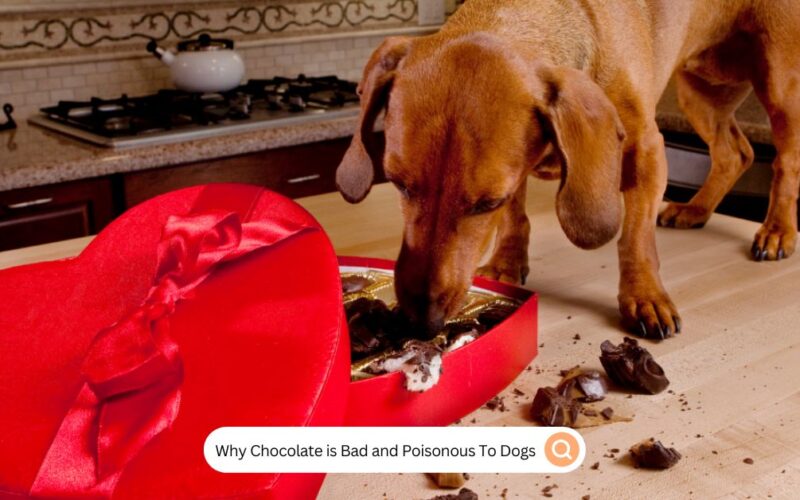About the Author: Introducing Dr. Adriana Luis, our Senior Content Editor at MyPetDoggie and also Veterinarian (MVZ). Kerry devotes most of her time to penning enlightening pieces about pet health, providing invaluable knowledge to pet owners globally. As the director of our Veterinary Content Team, she ensures the accuracy and comprehensiveness of our content, thereby making pet care accessible and understandable for everyone.
Your dog loves yummy treats, but you recently discovered that chocolate is bad and poisonous for dogs? Yes, it is. Being a dog enthusiast and lover, I always prefer what’s best for my dog. I could never think to harm my little fellow by any means. It is true that one of the yummiest treats for humans is contagious for dogs. So, be careful while choosing the right treat for your dog.
Let me take you in-depth on the reasons for chocolate is bad for dogs. If your dog ever eats chocolate mistakenly, this guide will also provide you an insight into various solutions. But it is better if you stick to treats that are dog-friendly.
Why Chocolate is Bad and Poisonous To Dogs?
A substance named theobromine is present in chocolate. Chocolate also contains caffeine. Both of these substances belong to methylxanthines. Methylxanthines can be a reason for disturbance in the dog’s cardiovascular system and central nervous system resulting in illness. Hence bad for Dogs.
Humans can metabolize these substances quickly as compared to dogs. That’s why they enjoy chocolate without getting any serious problems.

Dogs are not lucky in this matter. They are not able to metabolize these substances at a faster pace. This causes the development of toxins in their system. These toxins can be a reason for diarrhea, vomiting, restlessness, and even death. The reaction to chocolate varies depending on the amount of chocolate and the potential and size of the dog.
Keep in mind that dark chocolates contain more amounts of theobromine and caffeine. White chocolate is less toxic than dark chocolate. But still, it is preferable to keep any kind of chocolate away from your dog.
What Happens if a Dog Eats Chocolate?
Your dog has sneaked into the bar of your chocolate? And now he is feeling unwell? This is because of the reasons explained above. Theobromine is proven toxic for dogs. Dogs cannot handle the effects of this substance. Their body is sensitive to theobromine and caffeine. It can cause severe health issues, depending upon the quantity taken. It can also lead to the death of a dog.
The toxins in their body can cause them cardiac issues or it can affect their central nervous system. If your dog has eaten chocolate, make sure to visit the vet as soon as possible.
What Should I Do if My Dog Eats Chocolate?
It is better to prevent any situation that can hurt your dog in any way. But if your dog has accidentally fallen into a trap of this yummy treat, then don’t panic. Stay calm and understand the situation. Your dog is dependent on you for help. So try to act cautiously.

Act Quickly
Take immediate action and don’t waste time. Assess the situation considerately. More chocolate or dark chocolate can be more dangerous. In such a case, consult your vet quickly. Delays can cause more trouble for your dog.
Observe Symptoms
Symptoms depend on the amount of chocolate and the size of your dog. If the amount of chocolate is less and your dog is big, it may show minor symptoms. But if your dog is showing some significant or major symptoms, provide them medical attention immediately. Consider the consultation of your vet.
Do Not Induce Vomiting
If your vet doesn’t consult you, then don’t induce vomiting. It becomes very difficult for dogs to handle vomiting. Take the advice of a professional before doing anything. Experts know better, trust them. Your vet will advise you to induce vomiting, only if needed.
Know the Type of Chocolate
Different chocolates have different amounts of theobromine. I have already mentioned that dark chocolate contains more theobromine as compared to white chocolate. This shows that dark chocolate is more dangerous. You better try to identify the type of chocolate your dog ingested. It will help in treatment. Mild reactions and symptoms need mild medical care.
Prevent Access to Chocolate
Keep chocolate out of your dog’s reach. Chocolate is a yummy treat and it will become difficult for your dog to resist it. But once you get to know them, be careful and hide all the chocolates. You have the hold to keep your dog safe. Avoid eating chocolate in front of your dog. It is better to be safe than sorry.
Be Honest with Your Vet
Be clear and honest with your vet. Don’t forget that only your vet or any expert can help you with proper medical treatment. Tell the exact amount and type of chocolate. Provide your vet with accurate details. Because it will help him to figure out a better solution and treatment for your dog.
You might be interested in: Learn about the safety of dogs eating potato skins and potential risks
How much chocolate is poisonous to a dog?
There is no accurate amount defined. The amount varies for all dogs and depends on factors like the size of the dog and the type of chocolate. Your dog’s potential and size will help you to identify the appropriate amount. Different chocolates have different levels of toxicity. But still, it is not justified that chocolate cannot be poisonous in any way, sometimes a tiny amount can cause a big trouble. So, it’s better to prevent chocolate in any amount and of any sort.
What Are Symptoms That My Dog Ate Chocolate?
Symptoms can be moderate to severe, depending upon the sensitivity of your dog. The amount and type of chocolate can also play a huge role. Some common symptoms are discussed, so you can have an outlook and identify the severity. These symptoms will help you to give your dog the right treatment.

Vomiting
Vomiting is a protective mechanism. To protect the dog from any distress, his body will start throwing up. It is a sudden reaction to any toxins ingested. It means the body is reacting negatively. However, it does not guarantee that all toxins are removed by vomiting. It is just an indication that your dog needs medical assistance.
Diarrhea
Vomiting because of chocolate ingestion can affect the digestive tract. Violent contractions during vomiting can loss of the intestine. As a result, content moves too quickly through the intestine and it can cause diarrhea. We all know chocolate is sweet, it contains sugars and fats. Along with theobromines, dogs are also not able to digest those fats and sugars. It can upset their gastrointestinal activities.
Restlessness and Hyperactivity
The dog’s nervous system is affected by theobromine. It over-stimulates the nervous system which leads to restlessness and hyperactivity. Your calm dog can get hyper by the intake of chocolate. It badly disturbs the mind. Neurons in the brain are irritated and your dog can show signs of restlessness by continuous circling and pacing.
Increased Thirst
Polydipsia, known as increased thirst, is also one of the symptoms of chocolate intake. As discussed earlier chocolate can cause diarrhea and vomiting, which can be a reason for dehydration. Fluid loss is more frequent than normal. It triggers the body to increase the thirst rate to stay hydrated. The thirst rate is also increased to maintain kidney function. If your dog is drinking a lot of water, it is a red sign to get alert.
Increased Heart Rate
One of the significant effects of theobromine is disruption in cardiovascular activities. Heart muscles are stimulated by chocolate, which causes an increase in heart rate. Blood vessels are also affected by theobromine, they dilate. This lowers the blood pressure. To maintain adequate blood flow, the heart beats faster than normal. Theobromine activates the ‘fight or flight’ response, to which the heart rate increases.
Changes in Behavior
When the nervous system is irritated and the heart rate is faster than normal, it impacts the normal behavior of the dog. When your body is not at ease and it is suffering, how can you stay calm outside? The same is the case with dogs. Their behavior patterns change a lot. Dogs can show more excitement than usual and they can also be extremely aggressive because of the discomfort they have to deal with. Behavioral changes depend on their internal activities.
Collapse or Weakness
Dehydration, electrolyte imbalance, decreased blood pressure, and increased heart rate can cause weakness in dogs. A dog’s heart struggles more to maintain the blood flow. The central nervous system is also affected, which becomes a reason for lack of coordination, imbalance, and weak control of muscles. More or less, all these symptoms can affect the well-being of a dog and he can collapse or feel weak.
What is the treatment for chocolate poisoning?
Now you have become aware that your dog has eaten chocolate. You have noticed visible symptoms. It’s time to get the right treatment for your dog. But don’t try anything on your own. Consult your vet and follow his advice.

Induce Vomiting
Although normally it is not suggested to induce vomiting on your own. Because it can cause trouble for you later. The vet suggests to induce vomiting if chocolate is consumed recently. It can be helpful to remove the chocolate. If you notice consumption within hours and your dog is stable. Then it is preferred to induce vomiting to clean the stomach. But seek any professional help before taking this step.
Activated Charcoal
Activated charcoal helps remove the toxicity. It is helpful to remove the toxins from a dog’s body if given within the first few hours of chocolate consumption. The amount of activated charcoal depends on the size of your dog. You should use it under the administration of a vet. If you don’t use the right amount, it can also cause complications. So, be mindful of using activated charcoal. But it is only one aspect to treat the toxins and it may not work under certain circumstances.
Medications
After consuming chocolate, dogs have to go through various issues. To treat those issues, the vet suggests different medications depending on the problem and its severity. Antiemetics are used to treat excessive vomiting, they also prevent the electrolyte imbalance and loss of fluid. Intravenous fluids are used to prevent dehydration and regulate kidney function. Many other medications like antiarrhythmics (to maintain heartbeat), sedatives (to calm dogs), and pain management medications are also recommended by vets.
Supportive Care
The medical care and preventive measures taken are termed supportive care. Dogs get stressed because theobromine affects their mental activity. They can also be stressed due to the discomfort they have to face. Provide them with a quiet and comfortable environment to recover. Vomiting and diarrhea can cause excessive fluid and mineral loss, so take good care of your diet and nutrients. Some dogs need more time to recover as compared to others. So supportive care can vary.
Hospitalization
If your dog is severely affected by the toxins of chocolate, it is better to get them hospitalized. Hospitalization gives a better opportunity to monitor a dog’s condition. Medications are advised to be used under the administration. Appropriate dosage based on the dog’s response is easy to adjust. If your dog’s condition gets worse due to toxins, he can get immediate administered medical care. The calm environment will help your dog to relieve stress. Under the observation and care of professional experts, your dog will take less time to recover.
Which Chocolate Is Most Toxic to Dogs?
Cocoa powder and dark chocolate are considered the most toxic for dogs. Both of them have high levels of theobromine. A tiny amount can cause some potential and fatal problems. On the other hand, white chocolate and milk chocolate are considered less toxic because of their low theobromine content. But it doesn’t mean that dogs can have these chocolates. The tolerance and sensitivity towards toxins vary from dog to dog. Every dog has a different age, size, and breed. Even dogs of the same age can show variable responses. It is important to consult your vet on any minor inconvenience, to prevent any serious consequences later.
Top Highest-Containing treats and ingredients
I am sharing a list of some treats that contain toxic ingredients for dogs. It is not necessarily the only list of toxin treats, there could be more. Also, note that the number of toxins can also vary based on formulation and brand of treat. Double-check the ingredients and ask your vet if you are unsure about any ingredients. Do potential research before picking the right treat for your dog.
- Milk-Bone Biscuits : Contains wheat and artificial colors like red 40 and yellow 5. These ingredients are marked as unhealthy ingredients, they can also lead to cancer.
- Beneful Baked Delight: They may seem tasty but contain ingredients that are indigestible for dogs like ground wheat, ground yellow corn, and glycerin.
- Cocoa Powder: It is highly toxic because it contains high amounts of theobromine.
- Chocolate Chip Cookies: Containing chocolates can be toxic.
- Purina Alpo Snaps: High wheat, sugar, red 40, yellow-5 and yellow-6.
- Chocolate protein bars: They contain cocoa, which is highly toxic.
- Chocolate-covered nuts: Chocolate content can be toxic.
- Pup-Peroni: Contains sugar, salt, and red-40.
- Baker’s Chocolate: Toxic because of theobromine.
- Chocolate-Covered Espresso Beans: Theobromine.
- Rawhide treats: Dried animal skin, not easily digested.
- Milk chocolate: Moderate Theobromine.
- Wheat Biscuits: Contains wheat filling.
- Cocoa Mulch: Highly toxic for dogs because it contains high theobromine.
- Baking Chocolate: Extremely high theobromine.
- Semi-Sweet Chocolate: Contains theobromine and sugar.
- Hot Cocoa Mix: Contains cocoa powder, which has high theobromine and caffeine content.
- Coffee: Contains caffeine.
- Chocolate Ice-cream: Theobromine and milk.
- Chocolate Caramel: Theobromine
Common Question:
Why is chocolate unhealthy?
Chocolate contains unhealthy ingredients like sugar, fat, and additives. Consuming too much chocolate can be a reason for weight gain. If taken in moderate amounts, it can have some potential benefits.
Can dogs drink milk?
Dogs can have milk in moderate amounts. Milk is not considered toxic for dogs, but most of the dogs are lactose intolerant. They can’t digest milk properly. It is better to avoid milk for dogs or you can take professional advice.
Does milk help a poisoned dog?
No, it is not advised to give milk to a poisoned dog. It will not help to reduce the effect of toxins. Always seek professional help if you suspect that your dog is poisoned. Don’t try anything on your own. You may deteriorate the situation.
Why is coffee toxic to dogs?
Coffee has caffeine. Caffeine is toxic for dogs. They can’t metabolize caffeine quickly, and as a result they tend to face negative effects like vomiting, diarrhea, restlessness, and increased heart rate
Which chocolate is safe to eat?
For dogs, it is not recommended to have any kind of chocolate. But if your dog has enough potential to tolerate a minor amount of theobromine, then you can prefer treats including a little amount of white chocolate. It is preferred to ask your vet before giving anything to your dog.
Can dogs recover from eating chocolate?
Yes, dogs can recover from eating chocolate. If the amount ingested is little or they have been under good care and proper medication, they can recover. It also depends on the dog’s sensitivity to theobromine.
What should I do if my dog licks chocolate?
Monitor and observe your dog closely. Notice if your dog is showing any symptoms like diarrhea or vomiting etc. Licking the chocolate means the amount ingested would be minimal and if your dog is of a large breed, it may not affect him much.
Wrapping Up
No doubt, chocolate is delicious and yummy. But it is contagious for your fluffy pup. You are responsible for your dog’s health. A dog is not capable of thinking what is good for him. He will fall into a trap of yummy treats like chocolate.
But unfortunately, dogs are not as lucky as humans. Their body is sensitive to substances like theobromine and caffeine. They are not able to metabolize them quickly, which leads to some serious health problems for them.
Dogs are more prone to react towards chocolate. They show different symptoms like vomiting, diarrhea, restlessness and hyperactivity, increased thirst, rapid breathing, changes in behavior, or weakness.
If you are observing these symptoms, then it’s the best time to consult your vet or seek any professional guidance. Try and know the right amount and type of chocolate being ingested by your dog.
Keep your eyes open, don’t ignore these symptoms. Take action quickly, any delay can cause lifetime regret for you. Stay vigilant, act upon your vet’s advice, and lock the access to chocolate for your dog. Never forget that prevention is better than cure. Share with others so they can also be aware of symptoms and treatments.






